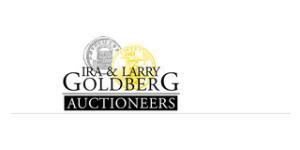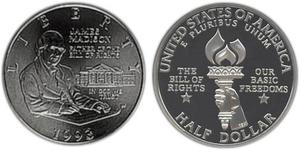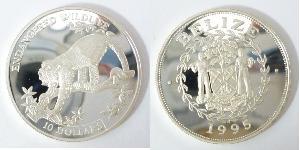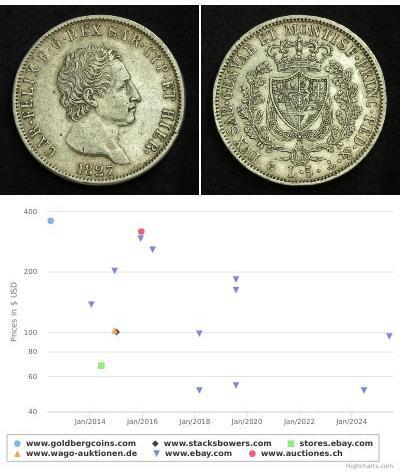1 Долар (продана за $90000.0)
1795 B-3, BB-11 Flowing Hair 2 Leaves Silver Plug Rarity 5 (Possibly Rarity 6/7 With Plug). PCGS graded AU-55 PQ. CAC Approved. Subset of PCGS # 6854. In a new secure plus holder. Condition Census. A marvelous example of this desirable variety. Each side exhibits stunning shades of iridescent blue, russet, and gold. The Silver Plug is emphasized majestically by the toning. This piece is truly a miraculous numismatic wonder! The bidder who is fortunate enough to win this coin will undoubtedly be mesmerized by it's sheer beauty. Pop 1; none finer at PCGS for the variety There is much to recommend this handsome specimen. First and foremost, it uses the desirable Head of 1794. Employing Obverse 1, Libertyís flowing locks are in six curls; the third from the top turns downward and touches the fourth curl. Two points of the first star touch the lowest curl which ends at star point. Finally, the last star or lowest one on the right is mostly under the bust, which a point nearly touches. Close date; there are outlines from repunching that appear at the top of the 5 and right top of the 7 (most visible on early impressions from the die). I closer to L than to B with L slightly low. This obverse die was used to strike 1795 BB-11, BB-12, and BB-13. It is paired with Reverse A: Two leaves under each wing. The only variety with 16 berries, eight on each branch of the wreath. There are only two berries on the left branch, between the eagle's wing and ribbon bow, both are on the inside of wreath. This reverse die is unique to 1795 BB-11. A scarce variety, between 31 and 75 1795 BB-11 dollars exist, making this one of the more elusive issues of the Flowing Hair type. In this condition, the coin is King, finest certified, and undoubtedly Finest Known. Noteworthy too, it is at least twice as rare as a 1794 dollar. The population of 1795 BB-11 seems to be clustered around the VF level which, of course, covers a fairly wide range (VF20 to just below EF40). Specimens are not easy to locate, according to the Bowers encyclopedia, "often a year will pass on the calendar without a single piece crossing the auction block.". (PCGS # 39990) Story of the Silver Plug Dollars: The curious silver plugs are known on several varieties, but usually on just a few coins of each. It is believed that during the planchet preparation process, sometimes planchets would be slightly underweight, and would normally have to be remelted, drawn and cut to size again. Someone at the Mint decided to use the 1792 silver center cent as an example, and drill out the center of the blank silver dollar planchet, insert a larger silver "plug", and strike the coin normally. The plug would flatten out and become a part of the coin, increasing the weight to the required standard. Ray Merena noted on this specimen that it has not only a silver plug, but also adjustment marks on the lower reverse rim. Why would someone add, then take away weight from the same planchet? Both the silver plug insertion and adjustment marks occurred prior to striking, so we can't be sure which came first, the plug or the adjustment marks. This particular specimen holds a very special importance among 1795 flowing hair dollars. Coming from the earliest, perfect-state of the dies, from the first die variety of silver dollars struck during 1795, this coin is most certainly one of the very first silver dollars struck during 1795. Among the known population of 1795 dollars with mint-inserted silver plugs, it is undoubtedly the very first one struck; it bears the very longest pedigree chain; and it is the very first specimen to have been described with a mention of the feature we now label as a "silver plug." In his "Silver Dollars & Trade Dollars of the United States - A Complete Encyclopedia," Q. David Bowers comments in relation to the Winsor-Wilson-Clarke-Ostheimer specimen of the B-7, BB-18 dollar, that "Walter Breen stated that he first noted the silver plug phenomenon "early 1956 on the Windsor-D.S. Wilson-Clarke B-7, but dared not use the word 'plug' or 'plugged' in the description lest it frighten off buyers!" Breen obviously was unaware of the present specimen, then impounded in the Garrett holdings, having already been off the market for more than seven decades. Breen was also unaware that auctioneer Lyman H. Low had recognized the rare feature of the coin in 1885, and like Breen, dared not call it a "plug" but instead described it as having the "planchet rough on bust, and similar defect on rev." (PCGS # 39990) . Estimated Value $75,000 - 85,000. Ex: Lyman H. Lows 8th Sale (June, 1885): Lot 59, bought at the sale by T. Harrison Garrett, Garrett Collection; Stacks (March, 1976): Lot 245; unknown intermediaries; Phillip Flannagan Collection, Bowers & Merena (November, 2001):Lot 4204, bought at the sale by the Cardinal Collection; Cardinal Collection Sale, American Numismatic Rarities (June, 2005): Lot 6; private collector; privately to the Cardinal Collection January, 2006; privately to Dr. Hesselgesser, February, 2008; The Dr. Hesselgesser Collection. Categories: Dollars
читати далі
Ціна

|
Добавив:
anonymous 2015-03-02 |
|
||
|
||
|
||
Можливо Вас зацiкавлять цi монети
2024-04-13
- Історичні ціни на монету
2024-04-15
- Історичні ціни на монету
Можливо, Вас зацікавить...

-600-300-CbMKbzbiNV4AAAFLlqijltwt.jpg)

-300-150-yb4KbzbiSd4AAAFLiC2jltwv.jpg)
 English
English









